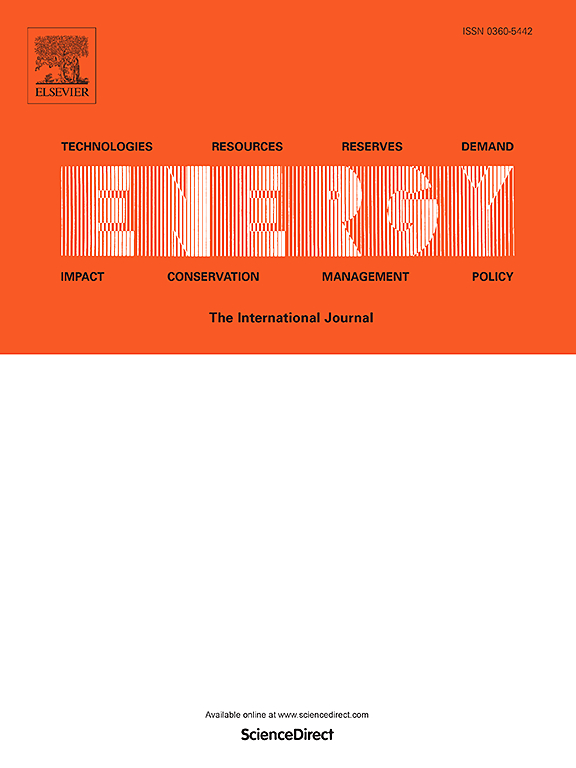Pyrolysis behavior of Sabina chinensis leaves: kinetic and thermodynamic analysis based on TG-FTIR and BP neural network
IF 9
1区 工程技术
Q1 ENERGY & FUELS
引用次数: 0
Abstract
Biomass resources play a crucial role in meeting our energy, chemical and material demands. Sabina chinensis, a biomass material with diverse constituents, can be effectively treated using pyrolysis, enhancing its resource utilization. This study investigated the pyrolysis behavior of Sabina chinensis leaves, whose pyrolysis process exhibited three distinct stages: (1) stage Ⅰ (moisture evolution), (2) stage Ⅱ (decomposition of hemicellulose, cellulose, and lignin, yielding CO2, methane, methanol, formaldehyde, and other products), and (3) stage Ⅲ (gradual decomposition of metal carbonates in residues). Using deconvolution and model-free methods, fundamental kinetic parameters for the pyrolysis of hemicellulose, cellulose, and lignin were estimated. Activation energies of 160.70, 180.49, and 159.73 kJ/mol were obtained for hemicellulose, cellulose and lignin, respectively. Thermodynamic analysis revealed enthalpy change values of 153.74–181.29 kJ/mol, Gibbs free energy change values of 277.94–338.10 kJ/mol, and negative entropy change values, demonstrating the energy potential of Sabina chinensis leaves. Furthermore, a backpropagation neural network, trained using mass and gas product data at multiple heating rates, successfully predicted the temperature-dependent mass loss and gas yield evolution throughout the pyrolysis process.
杉木叶片热解行为:基于TG-FTIR和BP神经网络的动力学和热力学分析
生物质资源在满足我们的能源、化学和材料需求方面发挥着至关重要的作用。杉木是一种成分多样的生物质材料,利用热解技术可以有效地处理杉木,提高其资源利用率。本研究考察了杉木叶片的热解行为,杉木叶片的热解过程表现为三个不同的阶段:(1)Ⅰ阶段(水分演化),(2)Ⅱ阶段(半纤维素、纤维素和木质素分解,生成CO2、甲烷、甲醇、甲醛等产物),(3)Ⅲ阶段(残渣中金属碳酸盐逐渐分解)。利用反褶积和无模型方法,估计了半纤维素、纤维素和木质素热解的基本动力学参数。半纤维素、纤维素和木质素的活化能分别为160.70、180.49和159.73 kJ/mol。热力学分析结果显示,林柏叶片的焓变值为153.74 ~ 181.29 kJ/mol,吉布斯自由能变化值为277.94 ~ 338.10 kJ/mol,熵变值为负,表明林柏叶片具有能量势。此外,使用多种加热速率下的质量和气体产物数据进行反向传播神经网络训练,成功预测了整个热解过程中与温度相关的质量损失和气体产率演变。
本文章由计算机程序翻译,如有差异,请以英文原文为准。
求助全文
约1分钟内获得全文
求助全文
来源期刊

Energy
工程技术-能源与燃料
CiteScore
15.30
自引率
14.40%
发文量
0
审稿时长
14.2 weeks
期刊介绍:
Energy is a multidisciplinary, international journal that publishes research and analysis in the field of energy engineering. Our aim is to become a leading peer-reviewed platform and a trusted source of information for energy-related topics.
The journal covers a range of areas including mechanical engineering, thermal sciences, and energy analysis. We are particularly interested in research on energy modelling, prediction, integrated energy systems, planning, and management.
Additionally, we welcome papers on energy conservation, efficiency, biomass and bioenergy, renewable energy, electricity supply and demand, energy storage, buildings, and economic and policy issues. These topics should align with our broader multidisciplinary focus.
 求助内容:
求助内容: 应助结果提醒方式:
应助结果提醒方式:


